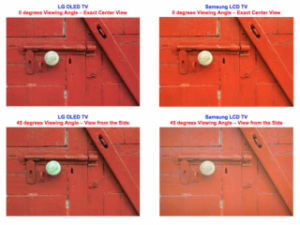In the latest Flagship OLED and LCD TV Display Technology Shoot-Out from DisplayMate Labs today, LG Display struts its stuff as chief researcher, Dr. Ray Soneira exposes the “Achilles Heel” of Samsung’s strategic decision to abandon OLED for its large display TV offerings, relying instead on liquid crystal technology combined with Quantum Dots (QD.)

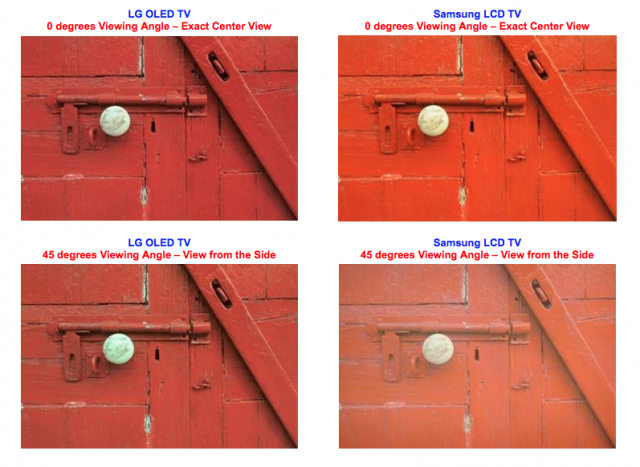 Side-by-side tests reveal measurable (and discernible) color shifts in off-axis viewing of the Samsung flagship 65-inch LCD TV (UN65JS9500) with quantum dots and full LED array, Copyright © 1990-2015 by DisplayMate® Technologies Corporation. All Rights Reserved, used with permission. The Off Axis Viewing or Viewing Angle of its newest 65-inch top-of-the-line LCD flagship (UN65JS9500), a QD set with full array LED backlight, takes a measurable performance hit, when viewed (as most are expected to be) at 45% off center line. The results are more stinging to Samsung when compared to the near perfect off axis viewing performance of LG’s flagship display (65EG9600) using emissive W-OLED technology (and color filters) to produce its groundbreaking image.The critical nature of a large display’s viewing angle performance was emphasized in the report with Soneira stating, “since only one person at a time can watch from the central Sweet Spot, [zero degrees off angle from the center line] how the picture quality changes (degrades) with viewing position and viewing angle is extremely important”. The introduction also include this: “Be forewarned that the Samsung LCD TV shows large viewing angle changes, which we’ll cover in detail below…”
Side-by-side tests reveal measurable (and discernible) color shifts in off-axis viewing of the Samsung flagship 65-inch LCD TV (UN65JS9500) with quantum dots and full LED array, Copyright © 1990-2015 by DisplayMate® Technologies Corporation. All Rights Reserved, used with permission. The Off Axis Viewing or Viewing Angle of its newest 65-inch top-of-the-line LCD flagship (UN65JS9500), a QD set with full array LED backlight, takes a measurable performance hit, when viewed (as most are expected to be) at 45% off center line. The results are more stinging to Samsung when compared to the near perfect off axis viewing performance of LG’s flagship display (65EG9600) using emissive W-OLED technology (and color filters) to produce its groundbreaking image.The critical nature of a large display’s viewing angle performance was emphasized in the report with Soneira stating, “since only one person at a time can watch from the central Sweet Spot, [zero degrees off angle from the center line] how the picture quality changes (degrades) with viewing position and viewing angle is extremely important”. The introduction also include this: “Be forewarned that the Samsung LCD TV shows large viewing angle changes, which we’ll cover in detail below…”
This is a comprehensive Flagship OLED and LCD TV Display Shoot-out report with multiple pages of side-by-side test results, so don’t miss the full version that can be viewed on-line at the DisplayMate Labs web site.
Both sets represent the cutting edge of large display technology today. Dr. Soneira calls this, “An impressive new generation of TVs with the very latest advanced display technologies …including the newest state-of-the-art large screen OLED displays and LCDs with Quantum Dots and Full Array Local Dimming, plus a new wide DCI Color Gamut, 4K Ultra HD resolution, and curved screens”.
Both sets are UHD, DCI Color Gamut compliant, with 65-inch curved screens. That said, 99% of TVs content is still sRGB / Rec.709 Standard and Color Gamut, “so it is essential that these latest TVs can also accurately display the large base of existing Full HD content with excellent picture quality,” Soneira emphasized.
My take: LG trumps Samsung outperforming it in all three major categories of viewing angle performance, changes in color, brightness and intensity scale. LG’s elegant solution to the industry’s top display technology challenges employs the company’s “simplicity-strategy” in implementing its large OLED display technology. To deliver next generation large screen TVs LG’s top management opted to license from Kodak a much simpler W-OLED (white OLED) approach using color filters, rather than tackle the complex chemistry and color half-life time variations that RGB OLED required of Samsung’s approach. The latter OLED technology was all but abandoned by Samsung for large display TVs and the company opted to use QD LCD (light gating) technology with its inherent off-axis viewing and contrast issues as evidenced here, yet to be fully resolved. For viewer convenience, we are including the direct link to the DisplayMate published test results showing changes in the image colors, screen brightness, black brightness, and intensity scales from the center of the screen 0 degrees viewing position.
– Steve Sechrist
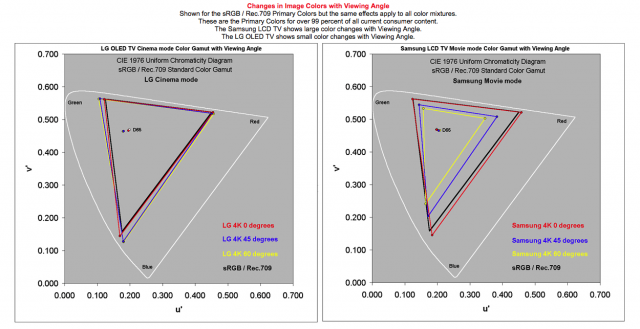 Copyright © 1990-2015 by DisplayMate® Technologies Corporation. All Rights Reserved, used with permission
Copyright © 1990-2015 by DisplayMate® Technologies Corporation. All Rights Reserved, used with permission
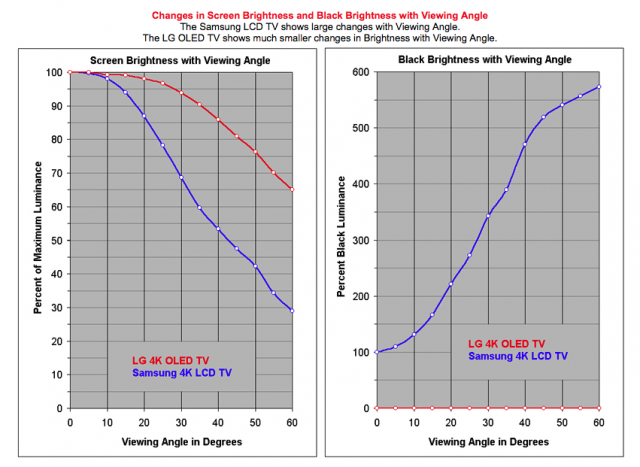 Copyright © 1990-2015 by DisplayMate® Technologies Corporation. All Rights Reserved, used with permission
Copyright © 1990-2015 by DisplayMate® Technologies Corporation. All Rights Reserved, used with permission
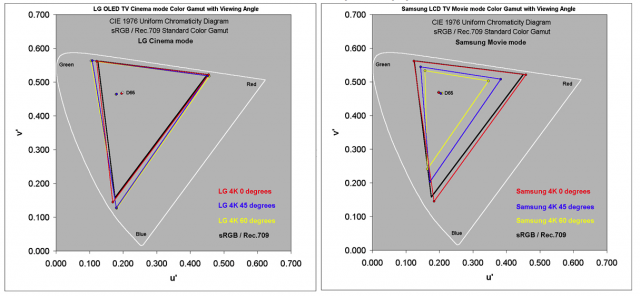 Copyright © 1990-2015 by DisplayMate® Technologies Corporation. All Rights Reserved, used with permission
Copyright © 1990-2015 by DisplayMate® Technologies Corporation. All Rights Reserved, used with permission
SS

